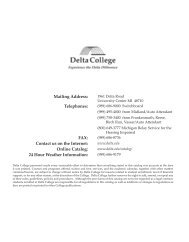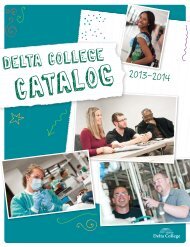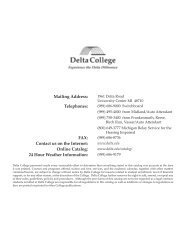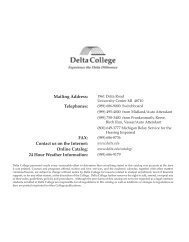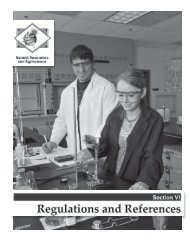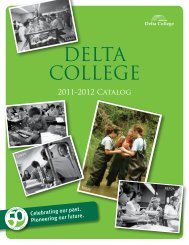2012 - 2013 catalog - Delta College
2012 - 2013 catalog - Delta College
2012 - 2013 catalog - Delta College
You also want an ePaper? Increase the reach of your titles
YUMPU automatically turns print PDFs into web optimized ePapers that Google loves.
EGR 166 Engineering Graphics 4 Sem Hrs<br />
Prerequisite: One year of high school mechanical drafting with final<br />
grade of C (2.0) or higher. A study of the graphic language applied<br />
to mechanical design, review of multiview and isometric drafting,<br />
and the geometry of drawing. Emphasis on developing skills in<br />
using orthographic projections, sectional views, auxiliary views and<br />
revolutions, dimensioning and annotation, and descriptive geometry.<br />
Computer-aided methods in drafting and analysis are used for all<br />
topics studied. Students cannot obtain credit for both EGR 165 and<br />
EGR 166. (30-60)<br />
EGR 215 Engineering Mechanics, Statics 3 Sem Hrs<br />
Prerequisite: MTH 261 and PHY 211 both with a grade of “C” or better.<br />
Develops skill in analyzing machine elements and structures, which are<br />
in static equilibrium. Solves forces and moments in 2D and 3D problems<br />
using vector calculus, integration, and algebra/trigonometry techniques.<br />
Includes concepts of centroids and moments of inertia and applies to<br />
mechanical linkages, disks and shafts, beams in bending, screw threads,<br />
trusses, frames, and vehicles. (45-0)<br />
EGR 216 Engineering Mechanics: Dynamics 3 Sem Hrs<br />
Prerequisite: EGR 215. Aims at students needing a second course in<br />
mechanics for engineers. Covers kinematics and kinetics of particles<br />
and rigid bodies in 2D and 3D. Uses force/acceleration, energy and<br />
momentum methods and applications to machine elements and structures<br />
in mechanical engineering. (45-0)<br />
EGR 221 Engineering Materials 3 Sem Hrs<br />
Prerequisite: CHM 111 and MTH 161 or equivalents. Introduces material<br />
classification based on their structure, properties and performance<br />
in various applications. Examines the micro and macro structures of<br />
metals, polymers, glasses, ceramics and composites and their structural<br />
relationship to their properties and performance in various applications<br />
Focuses on phase diagrams, microstructural changes caused by solidstate<br />
transformations, elastic and plastic behavior, the effects of the<br />
environment, and application selection criteria. (45-0)<br />
EGR 235 Circuit Analysis 4 Sem Hrs<br />
Prerequisite: MTH 161. Studies simple electrical components, rules,<br />
theorems and laws applicable to AC and DC circuits. Applies Kirchoff’s<br />
laws, Thevenin’s and Norton’s theorems, superposition, current and<br />
voltage divider rules, etc., Introduces circuit design techniques further<br />
study in transient circuits and three-phase power systems. (45-30)<br />
EGR 290-299 Special Projects in Engineering<br />
EGR 320 Mechanics of Materials 3 Sem Hrs<br />
Prerequisite: EGR 215. Considers effects of tension and compression,<br />
shear, torsion, bending and buckling loads on structures and machine<br />
members and their consequent effects on stress distributions and<br />
deformations. Emphasizes design as well as analysis. (45-0)<br />
Electronic Media<br />
EM 280 Digital Film Capstone 3 Sem Hrs<br />
Prerequisites: EMB 155 & ENG 258 with a grade of “C” or better. Provides<br />
experience in designing and producing digital short and/or partial<br />
feature films as part of production teams. Identifies, through teamwork,<br />
the specific production and postproduction needs for the projects and<br />
evaluates the clarity and quality of the writing, production design, and<br />
overall digital film product generated. (15-45)<br />
EM 290-299<br />
Special Projects in Electronic Media<br />
Electronic Media Broadcasting<br />
EMB 140 Electronic Media History 3 Sem Hrs<br />
Prerequisites: READING LEVEL 3 and WRITING LEVEL 3. Concentrates<br />
primarily on Broadcasting History, its roots and parentage. Compares<br />
relationships between past issues and personalities with those of today.<br />
Answers the question: Where do we come from and where are we going<br />
as a profession? (45-0)<br />
EMB 141W Fundamentals of Audio Production 2 Sem Hrs<br />
Introduces basic audio production methods and equipment, including<br />
non-linear editors, microphones, recorders and supporting hardware.<br />
Emphasizes developing comprehension of communication using<br />
aural mediums, and the variety of media types and formats available.<br />
Introduces the basic production skills necessary for developing audio<br />
projects. Uses radio labs and equipment to instruct students in basic<br />
elements of audio acquisitions, editing, and production. (15-30)<br />
EMB 151 Media Production I 3 Sem Hrs<br />
Introduces basic video production methods and equipment, including<br />
non-linear editors, video cameras and supporting hardware. Emphasizes<br />
developing comprehension of communication using visual and aural<br />
mediums, and the variety of media types and formats available. Introduces<br />
the basic production skills necessary for developing media projects.<br />
Uses Television Labs, Studios and equipment to instruct students in<br />
basic elements of video and audio acquisition and production. (40-20)<br />
EMB 152 Studio Productions 2 Sem Hrs<br />
Introduces basic television studio production methods and equipment,<br />
video cameras, switchers, audio boards, lighting and related hardware.<br />
Emphasizes developing comprehension of communication using visual<br />
and aural mediums through hands-on learning in professional studio<br />
environments. Introduces the basic production skills necessary for<br />
developing media projects. Uses television labs and studios to instruct<br />
students in basic elements in video and audio acquisition and studio<br />
production. (20-40)<br />
EMB 153 Broadcast Performance 3 Sem Hrs<br />
Introduces students to broadcast performance. Emphasizes presentations<br />
before microphones and cameras. Examines dress, movement, make-up,<br />
lighting, and delivery in such major performance situations as interviews,<br />
discussions, newscasts, commercials, and product demonstrations.<br />
Credit may be earned in either BRT 153 or EMB 153 but not both. (30-30)<br />
EMB 154 Peripheral Multimedia Applications 2 Sem Hrs<br />
Introduces and familiarizes student with operational elements of<br />
digital media, computer operating systems/platforms and peripheral<br />
multimedia applications which support and enhance digital non-linear<br />
video editing. Concentrates primarily on audio soundtracks, animated<br />
text, graphic design and proper compression for delivery to a variety of<br />
digital mediums. Emphasizes specific programs within the Macintosh<br />
OSX system. (15-30)<br />
EMB 155 Media Production II 4 Sem Hrs<br />
Prerequisites: EMB 151 with minimum grade of “C” (2.0). Builds on<br />
the body of knowledge gained in EMB151. Expands the knowledge and<br />
skill in composition of images and media, and integration of that media<br />
into finished productions. Introduces digital multimedia production,<br />
specifically Macintosh Computer systems and Final Cut Pro non-linear<br />
editors. Uses both studio and computer editing facilities to refine both<br />
audio and video production skills to develop and execute productions.<br />
Uses Television, Radio, and computer labs. (45-45)<br />
EMB 161 Podcasting, Online, and Mobile<br />
Media<br />
2 Sem Hrs<br />
Introduces and familiarizes student with basic elements and theories of<br />
alternative/online forms of multimedia delivery, including audio and<br />
video podcasting, mobile media devices, media enhanced blogging and<br />
media delivery through video sharing and social networking sites such<br />
as YouTube and Facebook. (15-30)<br />
EMB 175W Genres in Film History 3 Sem Hrs<br />
Examines major film styles and genres prevalent through the history<br />
of American cinema. Discusses groundbreaking works and popular<br />
film styles and analyzes their production values, editing techniques<br />
and influences on later films and other media. Researches individual<br />
directors and films and presents written critical analysis of technical<br />
and influential contributions to filmmaking. (45-0)<br />
<strong>Delta</strong> <strong>College</strong> <strong>2012</strong>-<strong>2013</strong><br />
Prerequisite Levels - See charts in this section.<br />
369



